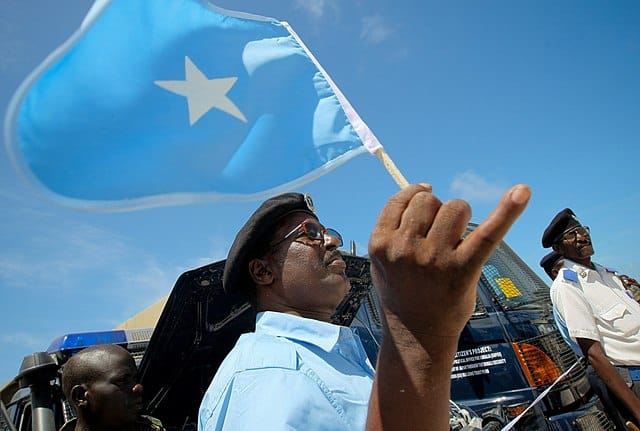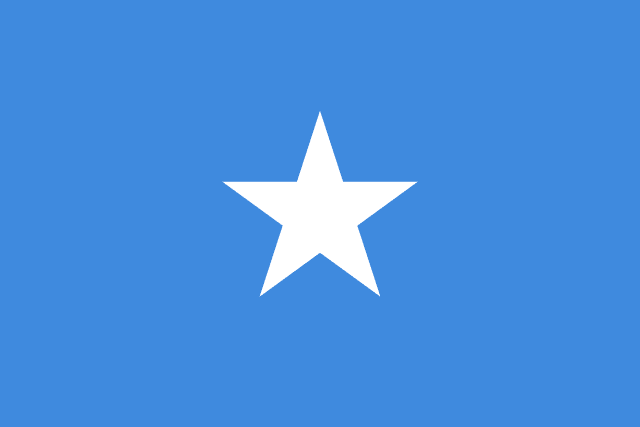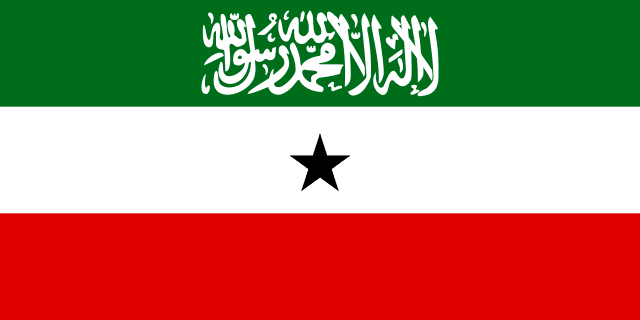On October 12, 1954, the flag created by Mohammed Awale Liban was approved as the. The flag was unveiled by the Somali Republic following the union of the Italian and British Somalians. The country had a difficult past, which affected the development and design of its flag too.
Below in this article, you will come across some valuable information regarding the Somalia flag and the country’s history.

Geography of Somalia
Somalia is a hot, arid land located in northeastern Africa. Numerous individuals live nomadically, or “roaming,” lifestyles in order to survive in this hostile climate. Its capital is called Mogadishu. The eastern region of the continent, the Horn of Africa, is where Somalia is located. The Indian Ocean is to the east, while the Gulf of Aden is to the north. Kenya, Ethiopia, and Djibouti are Somalia’s land neighbors.
Most of the terrain is made up of plateaus and plains, which are elevated, flat landscapes. The northeast is home to mountains. Surud Cad, at 7,897 feet, is the highest mountain in the nation. Along the east shore, there are sand dunes. The southern region is traversed by the Jubba and Shabelle rivers. The richest agriculture in the nation is located between those rivers.
One of the hottest nations in the world is Somalia. Compared to the northeast, which is quite dry, the southwest and northwest receive more rain. Arabic and Somali are both official languages. Italian and English are also spoken by certain people. Before 1973, the Somali language lacked a written form.
Eastern Africa Time (EAT), which is UTC + 03:00, is time in Somalia. The coordinates for Somalia are 10° 00′ N and 49° 00′ E. Being three hours ahead of UTC is therefore extremely appropriate for Somalia and not at all unexpected.

History Of Somalia
The shores of Somalia were most likely a part of Punt, a prehistoric country referenced in texts by the ancient Egyptians. Arabs and Persians established commercial sites along the beaches between the 600s and the 900s. Somali nomads had arrived in the region by the 900s.
In the 1800s, Europeans began exploring the area. British Somaliland is the region in the north that the British seized control of in 1884. Italy quickly occupied several areas in the northeast and on the southern coast. The territory claimed by Italy was known as Italian Somaliland. British and Italian Somaliland became independent states in 1960. Together, they created Somalia as a new nation.
The military seized control of Somalia’s government in 1969. The military administration was overthrown by insurgents in January 1991. The nation was then divided into a number of areas, each of which was ruled by a particular clan or set of clans. The former British Somaliland province proclaimed its independence as the Republic of Somaliland in May 1991.
As the tribes struggled for territory, civil war broke out. Puntland, a region in northeastern Somalia, also established its own government in 1998. All of the warring factions’ attempts to reconcile in the 1990s were unsuccessful.
In 2004, a new Somali government was established outside of the nation. The Transitional Federal Government (TFG) was its official name. The TFG had its first meeting on Somalian soil in 2006. Elections were held in both 2012 and 2016–17. Even though it was thought that violence and corruption plagued the 2016–17 elections, it was nevertheless seen as a positive development for the unstable nation.
Somalia Flag History
First Somalia Flag
In documented history, a lot of different Somalia flags have been flown. The earliest is linked to the royal families that dominated the area before colonial times. Between 1415 and 1577, the Adal Sultanate’s flag was flown locally. There were three parts to it. White rectangles with red crescents made up the hoist and fly parts, while the center area had the opposite color scheme.
Part of contemporary Somalia was also governed by the Arjuran Empire. Its flag had a white crescent around the hoist and was made up of a triangular red and yellow pattern. It was in use between the 13th and 17th centuries.
Ottoman Empire Flag
Between 1559 and 1867, a different region of the country’s flag was represented by a version of the Ottoman Empire’s flag. It was shaped like a large triangle, and the hoist had a golden crescent and a crimson field. The Ottoman flag’s design served as the inspiration for this one.
Flag Of Colonial Western Governments
The Somalia flag underwent more alterations in the 20th century. The Dervish State ruled over some of the lands at one point, while European nations also had control over some of them. They each had a different flag. The Italian and British colonies adopted variants of their own regular colonial Somalia flags, while the Dervish State flew a flag made up of stacked red and blue rectangles.
The colonial governments of the west have been encroaching on Somalia since the 19th century. After successfully occupying Somalia in 1884, the British established the colonial zone known as the British Somalian in the country’s north. On the East Somalian beaches, the Italians established the Italian Somali, another colonial entity, in 1889. The Italian Somalis were conquered by the British in 1941, and the Italians regained control in 1950.
Under Italian rule, Somalia’s coat of arms had the colors blue and white as well.
Current Somalia Flag
Areas in the Horn of Africa inhabited by Somalis were split among Ethiopia, France, Britain, and Italy starting in the middle of the 19th century. The Somalia flag was designed in 1954 to represent the nation’s history of transitory trusteeship. Mohammed Awale Liban, a representative of the Somali council, created this flag.
An ethnic flag with a five-pointed Union Star in the middle, it is used to signify the Somali population in Djibouti, Ethiopia’s Ogaden area, Kenya’s Northeastern Province, and the former Somali population of Italy. The United Nations flag served as the inspiration for the flag’s blue hue. The United Nations’ contribution to Somalia’s independence is the cause of this.

Flag Of Autonomous States Of Somaliland
On June 26, 1960, the new national flag, which stood for unification and freedom, was officially adopted by Somaliland. It was also adopted a few days later, on July 1, by the former Italian Somalia. Between June 26 and July 1, 1960, the short-lived autonomous state of Somaliland used the same flag.
The flag of the Democratic Republic of Somalia changed across all Somali territories. But the occupied regions controlled by the British and the Italians rejected it. In Somaliland, it is against the law to fly the Somalia flag.
Flag Of Somaliland
The Somaliland flag, known in Somalia as “Calanka Soomaaliland,” was approved on October 14th, 1996. Green, white, and red make up its tricolor, with a black star in the middle. The Shahada is written in white calligraphic script on a green stripe.
According to Article 7 of Somaliland’s Constitution, which was approved by referendum on May 31, 2001, the flag of the Republic of Somaliland shall consist of three horizontal, parallel, and equal sections, the top section of which is colored green and has the Arabic phrase “There is no god but Allah, and Muhammad is the messenger of Allah” written in the center of it in white, the middle section.
The administration has established guidelines for flying the flag. It should be handled with deference, caution, and understanding. Regulations on the use of the flag have been set due to the Shahada’s significance in Islam. According to these regulations, flying the flag at half-mast is considered insulting and un-Islamic.
A person may also face charges of flag desecration if they are observed lowering the flag to half-mast. For the same reason, the flags of Afghanistan, Saudi Arabia, and Iraq are all subject to similar regulations.
Although the bottom of the flag should be red, as stated in the aforementioned Article 7, several miniature copies have been spotted with a clear orange tint instead. Another difference is the star’s orientation since it often points in the opposite direction from other flags on Somaliland flags. The majority of Somaliland flags have a ratio of 1:2. It is based on the Union Flag of the United Kingdom, the former colonial authority, which has an official ratio. Many times, images of flags on the internet and elsewhere mistakenly depict a shorter flag.

Symbolism Of Somalia Flag
The current Somalia flag features a brilliant blue background with a white star in the middle. The white star is composed of five points, one representing each of the areas that the Somali people once called home.
The United Nations flag, which was very influential in the country’s decolonization and subsequent transition to independence, inspired the light blue field. It is also seen as a representation of the sky that covers Somalia and the Indian Ocean, which extends beyond the country’s coast and contributes significantly to its prosperity.
Bottom Line
Above in this article, we discussed the development milestones of the Somalia flag. The Somalia flag and the UN flag are very similar. The resemblance arises from the fact that it is a gesture of gratitude to the UN for supporting Somali independence. A white star with an angular shape is in the center of the blue flag.